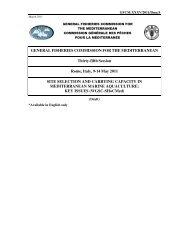English
English
English
You also want an ePaper? Increase the reach of your titles
YUMPU automatically turns print PDFs into web optimized ePapers that Google loves.
48<br />
GFCM:SAC13/2011/Dma2<br />
spawning ground for some species being carried out by some countries. Critical habitats<br />
should be identified for conservation porpoises. Otherwise, Sharks are protected in MPAs<br />
along with other marine species but no MPAs established with reference to these species such<br />
as PELAGOS Sanctuary (for cetaceans) and the two MPAs: Larvotto (Ordonnance<br />
Souveraine du 25 avril 1978) and Spélugues (Ordonnance Souveraine du 29 août 1986) in<br />
Monaco.<br />
Marine protected area can be efficient to manage sharks fisheries: (to protect nursery area,<br />
parturition zone….).<br />
Temporary closure of fishing area can be efficient to reduce capture of critical stage of the life<br />
history of the species (new born, pregnant females….). In Tunisia the gulf of Gabès is closed<br />
to trawling fishery from July to Septembre,<br />
III-6 Regulation of shark finning<br />
Shark fins are among the most highly priced fisheries products in eastern Asia and this is<br />
stimulating the targeting of sharks and retention of only their fins, the practice known as<br />
‘finning’.This practise is wasteful of protein and other potential products derived from sharks.<br />
In fact only fins are used, the remainder being thrown away. Finning causes the death of tens<br />
of millions of sharks in the world, directly threatening rare and vulnerable shark species and<br />
indirectly impacting other commercial species due to the effects of removal of top predators<br />
from these food webs.<br />
As fining activities don’t take place generally in Mediterranean countries, there are no<br />
national regulations of shark fining except in Spain. However, Regulation EC n°1185/2003<br />
bans removal of fins followed by discard of the carcass at sea. Finning with retention of<br />
carcasses on board is permitted in accordance with the provisions of Regulation. The<br />
theoretical correspondence between the weight of fins retained and the parts of the bodies<br />
retained on board should be established by the Member States but cannot exceed 5% of the<br />
live weight of the shark catch. In Mediterranean, this activity is likely to interest more and<br />
more fishermen.<br />
The ICCAT 2004 regulation and the GFCM 2005 regulation recommend the full utilisation of<br />
sharks (only head, skin and guts may be discarded). Landed fins are not to exceed 5% of<br />
landed shark weight. The live release of incidentally caught sharks is encouraged but not<br />
required.<br />
In Spain, the order of the Ministry of Agriculture, Fisheries and Food, dealing with specific<br />
conditions for the catching of sharks (June 2005), prohibits shark finning (removal of fins and<br />
discarding the carcass at sea). It is prohibited to hold on board, unload, tranship or transport<br />
sharks’ fins without the corresponding weight of the rest of the body. In cases where fins or<br />
the rest of the shark’s body are held on board, transhipped, unloaded or transported<br />
separately, they should be accompanied by a document certifying the placing on the market of<br />
each part, as applicable. Such activity is therefore permitted only under special permit in<br />
accordance with EC Regulation n° 1185/2003.
















